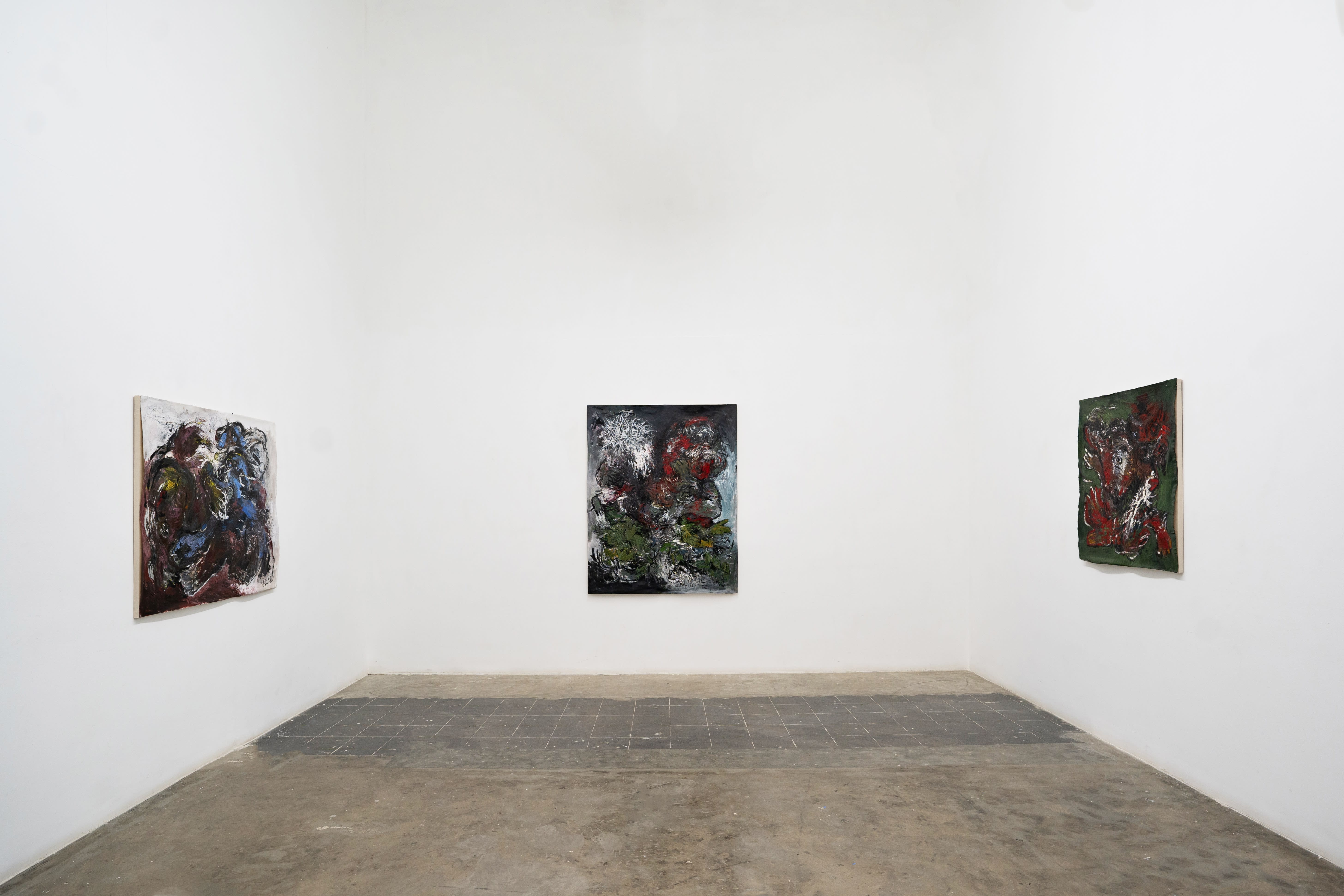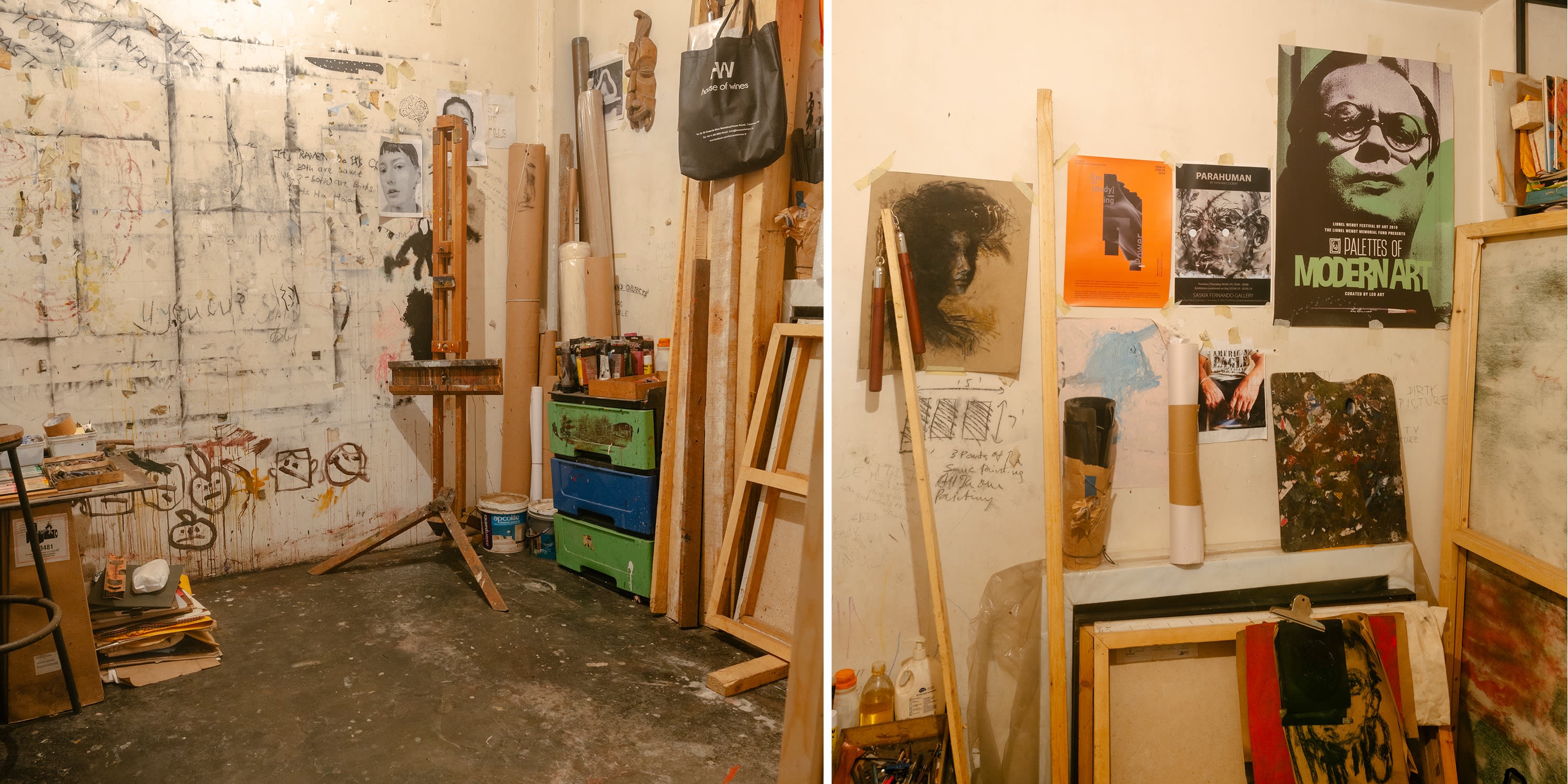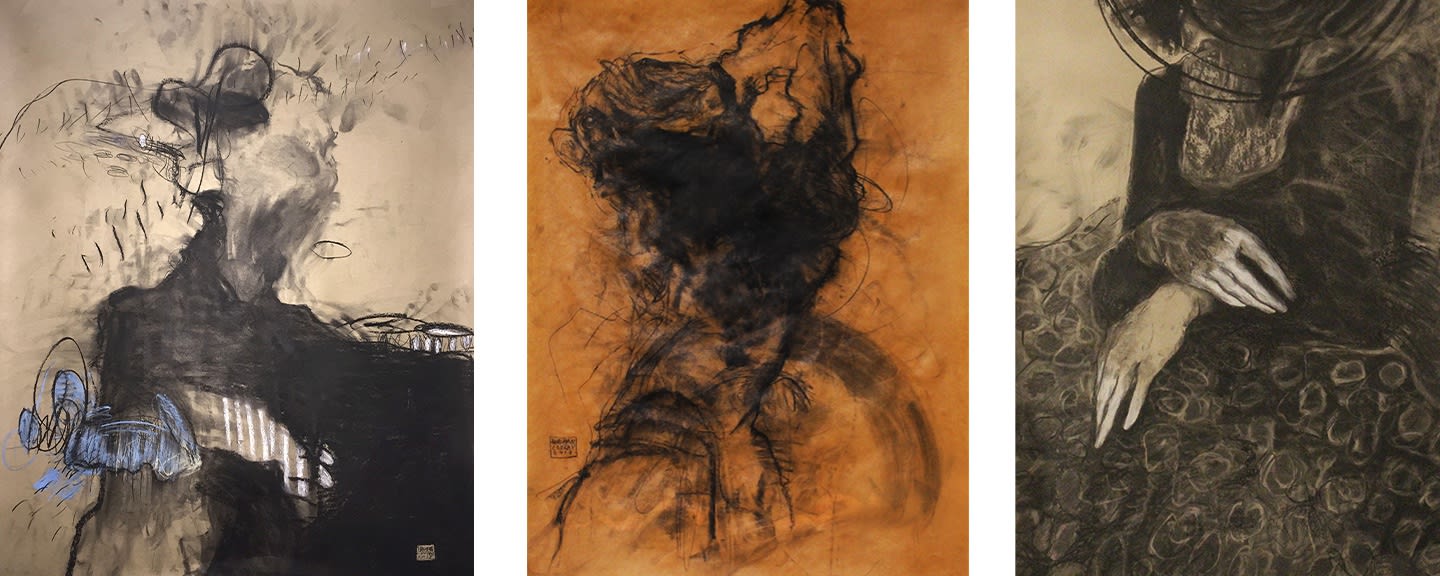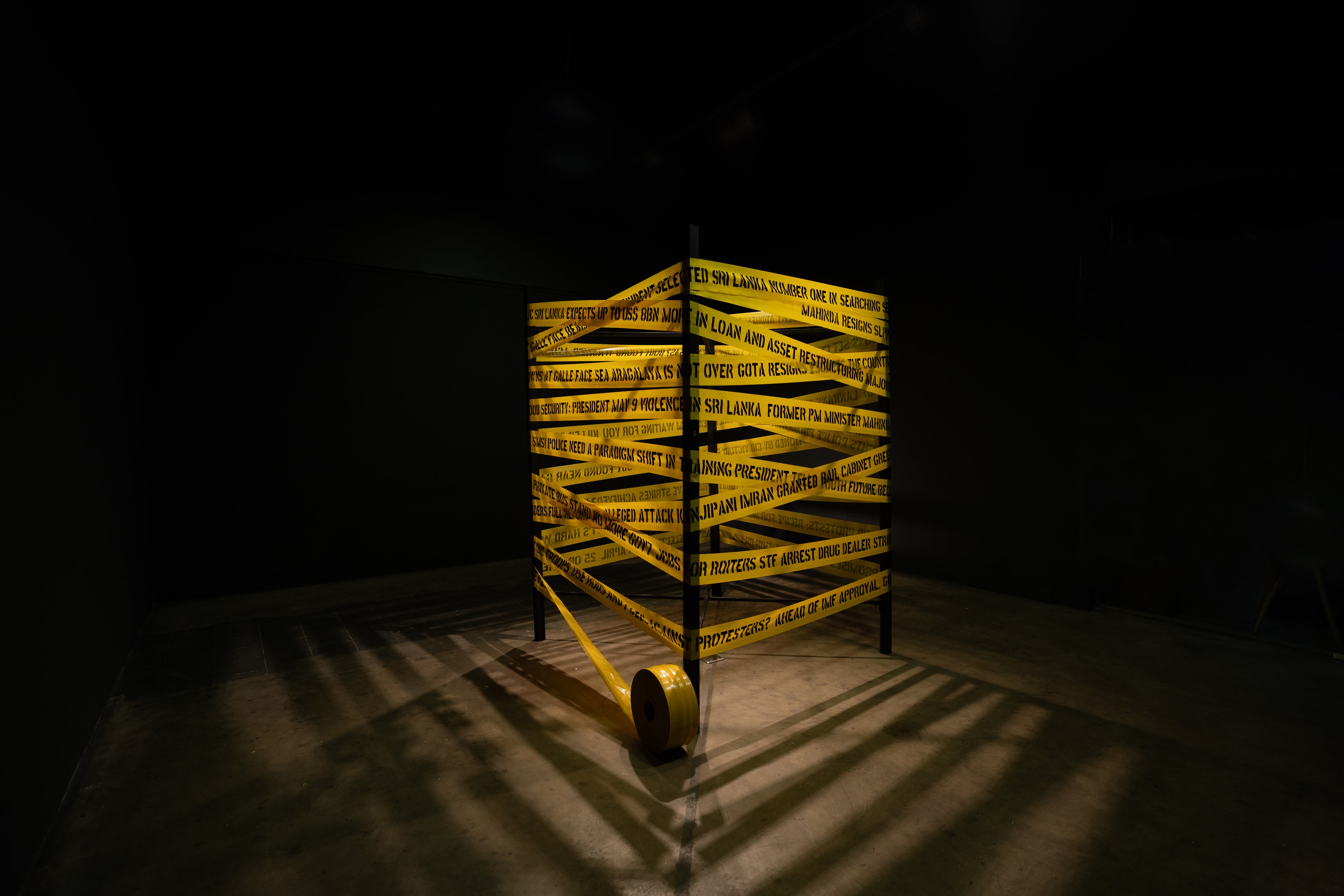|
Hashan Cooray is an artist based in Colombo. He combines drawing, painting, digital art, installation and mixed media collage to engage his subjects beyond the stereotypical translation of portraiture. The artist repurposes the artefacts of nationalism, capitalism and consumerism such as propaganda posters and commercial advertisements. He presents multi-layered and textured portraits that interrogate the psyche of individuals influenced by the over-consumption of media. Characterised by an intense gestural quality that portrays his subjects in an intrusive manner, his work provides a stark image of the impact of an oppressive regime and consumerist culture on society and its denizens. His work has been featured in both group and solo exhibitions at Saskia Fernando Gallery, Sri Lanka and has been published in the Imago Mundi Book Project by the Benetton Foundation.
|
 |
In advertising, we attach emotion and bonds to the products linking them with our memories, phrasing a catchy slogan. We constantly struggle with aligning our cultural values with the pace of contemporary life, often trying to project an image and identity through the brands we consume. |
What is a typical day like for you?A typical day for me, as a Creative Head at Ogilvy with 14 years of experience in the advertising field, is a blend of structured and unstructured activities. It's not a conventional 9-to-5 job; it's more of a 24x7 engagement. My thought process is constantly active, whether I am at work or not. Even if I'm not practising my craft every single day, I'm always thinking about it, refining ideas, and developing concepts.
In advertising, creativity doesn’t stay to a schedule. Inspiration can strike anywhere, even in the shower, and when it does, I take it and shape it into something that can sell an idea to a client. This industry is about selling, and I am deeply involved in it. Time management is crucial because ideas and insights come at unpredictable times, and I need to be ready to capture and develop them.
Despite not having a formal education in art, my career in advertising has provided me with a structure and a framework to apply my creative and strategic thinking. Each project begins with a problem that needs solving. I ask many questions to build a comprehensive approach: who is the audience, what message needs to be conveyed, and how can I make it resonate? This process involves thorough research and a strategic application of creative theories.
I have immense support from my family, and there is no pressure from them. Growing up without a strict timetable allowed me to develop a flexible and creative mindset. I am deeply grateful to my parents for this freedom, which has greatly influenced my ability to think creatively and manage my time effectively.
Hashan's studio in Colombo, Sri Lanka
|
|
Please tell us a bit about your journey AS AN ARTIST.
I networked with cultural institutions in Colombo, like Saskia Fernando Gallery, Lionel Wendt Art Centre, and Goethe Institute. I was curious about the international art scene, from ADND to Brazil to Cannes. My advertising career, which included work with Adweek, gave me financial stability to pursue my art. I started small, creating pieces on tea cartons, milk powder boxes, and cement paper. I loved designing and printing catalogues—they felt like complete works compared to my raw drawings. I set my sights on working with SFG, Sri Lanka’s top gallery. Over three years, I sent them three proposals. I'd get feedback, and meet Mr. Fernando with my art (even taking my large canvases in a lorry!), but my early attempts were rejected. Undeterred, I showed my work at Kala Pola. Eventually, Saskia saw my work and offered me exhibition opportunities.
I have exhibited at the Nawa Kalakaruwo for three years now. My ultimate goal was always to work with SFG, and I managed to get there on my third attempt. My wife knows that I've always been like this. Back in school when we were dating, I’d tell her I wanted to work at Leo Burnett every time we passed their offices on Duplication Road, one of the top ad agencies in the world, and I managed that in seven years. I said the same about working with SFG, and now here I am. Persistence and passion have always driven me to hit these milestones.
Left: 2018 Hidden Victory, Charcoal on Paper, 62 x 50 cm
Center: 2018 No-One-Else, Charcoal on Paper, 62 x 50 cm
Right: 2018 Behind Her, Charcoal on Paper, 62 x 50 cm
Exhibited at Embodying Power, Sapumal Foundation, Colombo, Sri Lanka, 2018 Curated by Tamara Fernando and Sandev Handy
|
IN YOUR WORK, YOU ARE CONCERNED WITH EXAMINING THE INNER WORLD OF PEOPLE, AND QUITE OFTEN IT IS AN EXPRESSION OF IMMENSE PSYCHOLOGICAL DISCOMFORT. WHY ARE YOU DRAWN TOWARDS ENGAGING WITH THIS ASPECT OF HUMANITY?It is within that discomfort that struggle exists. I always wanted to do something innovative with my art. I didn't have a solidified identity as an artist, I am still evolving. I didn't try to build or maintain one. Even though all these pieces are mine I am a firm believer of anti-art. It is through this concept that I break from beautification and other elements of traditional art practices. These works are royalty free. Even the imagery of the gods is ugly and broken. I would make a statue and break it. I form and deform. I voice this belief passionately. I don’t have any teachers whom I am beholden to. I have no pedigree to protect. Just myself. That gives me a lot of freedom and liberty. This is my jungle within which I play and explore.
Left: 2018, Liminal Space II, Mixed Media on Paper, 100 x 80 cm Center: 2019, Anima Animus I, Charcoal on Paper, 69 x 51 cm Right: 2019, Peacock Feathers II, Charcoal and Soft Pastel on Paper, 99 x 72 cm
|
HOW WOULD YOU SAY YOUR PRACTICE HAS EVOLVED IN THE LAST DECADE?My art has progressed in a direction that aligns with my darker, bleaker perspective on the world. I see two types of artists: those who express the world as it is and those who seek a different way to see it. I fit into the latter group. This outlook isn't necessarily negative; it just reflects a different reality, especially in the context of Sri Lanka.
In Sri Lanka, this darker exploration can be seen in the works of artists like Lester James Peries, Simon Navagattegama, and Martin Wickramasinghe, who delve into the darker sides of the elite classes. However, there aren’t many Sri Lankan artists focusing on the bleaker aspects of ordinary life. Artists like Ivan Peiris and Lionel Wendt touch on these themes but they often prioritise aesthetics over subject matter. I wanted my art to be a political statement, an innovative way to express my understanding of the world. My work is a raw and pure expression of my beliefs.
Private Collection: 2016, Silent Valley, Mixed Media on Canvas, 60cm x 60m I’ve always been intrigued by how humans are portrayed in art. Inspired by a biblical quote suggesting that humans give sustenance to gods, I wanted to question this dynamic.
This approach to art has allowed me to explore and express my political views in a manner that is very personal and direct. It’s been a journey of challenging norms and presenting a different perspective on life and humanity.
Stick No Bills, Saskia Fernando Gallery, Colombo, Sri Lanka, 2022
|
COULD YOU ELABORATE ON YOUR RESEARCH BEFORE WORKING ON A NEW SERIES?Before starting on a new series, I immerse myself in research, staying updated on current events, particularly in politics, as well as delving into theoretical concepts. I question how history repeats itself and try to view contemporary society through the lens of these theories I've encountered.
From my first exhibition, "LAB RATS," to my latest ones, I explore themes such as what we consume, what we believe, and the clashes that arise from these. I focus on finding the spark point, the moment where these tensions become most palpable and significant. In "LAB RATS," for example, I honed in on the notion that those in the third world are often treated as mere lab rats for experimentation by the first world. I wanted to highlight the idea that we are essentially beholden to an unknown master within our invisible cages, subjected to forces beyond our control or understanding. This process of research forms the foundation of my work. |

Left: 2017, Ears Only II, Mixed Media on Board, 30cm x 24cm
Right: Labrats, Saskia Fernand Gallery, Colombo, Sri Lanka, 2017
HOW DO YOU CRITICALLY ENGAGE WITH THE IMPACT OF ADVERTISEMENTS IN DYSTOPIA?
I do look into how behavioural changes are influenced by advertising and how it impacts our world in various ways. The title work of the latest series features a dancing Ganesh, portrayed in an untraditional way. By depicting Ganesh in the Natarajah stance, often associated with the dance of death, I seek to disrupt existing ideas of the god. Even an all powerful god like Ganesh can fall. (If Gota can go home, so can Ganesh!). My practice has started to clash with our cultural affairs, which is something artists in Sri Lanka try to stay away from. I wanted to question cultural stigmas but since my visual language is very different it isn’t very apparent. This series does not have overlapping figures. The composition is more planned out and precise, and central. I use an earthy colour palette and even the typography is different from my previous series STICK NO BILLS although it takes some elements from it. There’s an aged quality and a sense of progression to this series.

IS THERE A SPECIFIC ENVIRONMENT OR MATERIAL THAT IS INTEGRAL TO YOUR WORK?
|
|
|
HOW DO YOU USE TYPOGRAPHY IN YOUR WORK AND WHY?I try to incorporate elements from ads and logos into my work because they represent the complexity of our cultural life. These value play a significant role in shaping our identities and experiences.
Today, we live in a world of excessive consumption, where everything is vibrant and colourful. However, this consumerist culture often clashes with our deeper cultural attachments and values. We attach emotion and bonds to the product we consume and we attach memories. We exploit this in advertising. We synthesise this into a phrase or a campaign: Just Do It, I’m Loving It, Impossible is Nothing. An experiment I would love to try is to put these phrases and campaigns in place of worship. I would get chased out immediately but isn’t this what we essentially do in our lives? We think about cultural attachments and the products we consume using the same part of our brain. Our struggle comes from the attempt to reconcile these two very different elements.
While technology has advanced rapidly, our cultures have not evolved at the same pace. We often try to apply old values to contemporary life, resulting in a constant tension between tradition and modernity. In this context, we must always be mindful of protecting our reputations, ensuring that our consumption aligns with the image we project to the world. I can’t sit at a kadé on the road and have tea without creating a scandal because that does not fit the reputation that people have given me. It is this psychology that I try to examine in my work through the use of logos and ad campaigns.
Right: 2022, Stick No Bills #24, Offset Print on Paper, 36 x 48 cm Left: Hashan's studio
|
|
HOW DO YOU NAVIGATE THE SPACE OF BEING IN A FIELD THAT IS CONSUMERIST AND CAPITALIST IN YOUR DAY JOB, WHILE BEING AN ARTIST WHO CONFRONTS THE ISSUES THAT ARISE DUE TO IT THROUGH YOUR WORK?For me, the artist is an honest character. My work in advertising is purely my job, and I produce art within this system, similar to the critiques by artists like Warhol, Duchamp, and Manzoni. They engaged in anti-art while living and taking inspiration in major metropolitan centres like New York and Chicago. That's what I do as well.
My advertising work gives me a deeper understanding of the system, which enriches my critique of it. In advertising, I need to understand the negatives of a brand to highlight its positives. People often criticise me for producing this kind of art while working in the industry I critique. To them, I say, I have to go to the temple to see if the gods are really there.
Andy Warhol, 1962, Cambell's Soup Can
What are the sources that you draw influences from?My inspiration comes from a variety of sources, but I particularly draw from advertisements and books on branding. I'm fascinated by the way brands construct their identities and the messages they convey through their marketing materials. I have a collection of packaging from various products, which I've gathered from friends who use different mixes of products. Each family has its own consumption patterns, which I find intriguing.
I incorporate these elements into my work to explore complex themes and societal issues. For example, in one piece, I used the imagery of the well-known brand Coca-Cola to question the difference between starvation and dieting, the tension of not eating out of choice and not having a choice at all. By focusing on the brand of Diet Coke, I wanted to create a conversation on the impact of consumerism and marketing on our choices. |
|
What are you reading?I enjoy art books, as well as literature from the Soviet era. At the moment, I'm engrossed in a book about political murders in Sri Lanka titled "Batalanda Gini Thabuwemu" by Nandana Weeraratne. Additionally, I'm reading through the court order on the murder of Vijaya Kumrartunga.
WHAT WOULD YOU LIKE TO EXPERIMENT WITH AS AN ARTIST IN THE IMMEDIATE FUTURE? DO YOU HAVE A DREAM PROJECT YOU’D LIKE TO WORK ON?
My dream project is to create installations that address political incidents here in Sri Lanka, allowing me to speak out on important issues in a powerful and impactful way. I believe that installations have the potential to resonate with audiences internationally, shedding light on events that may not have received widespread attention outside of the country. While there may be few artists who have had the courage to tackle such topics, like Chandragupta Thenuwara and his Barralism, I am committed to using my art as a platform for social and political commentary.
Printed Baricade, 2024, Stencilled Tape and Iron Structure, Dimensions Variable
|
|









